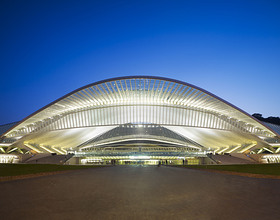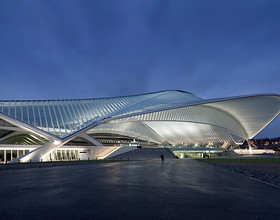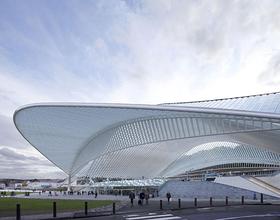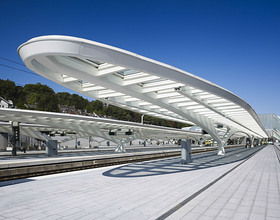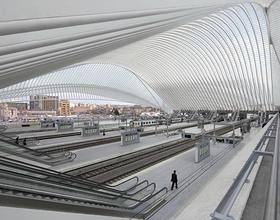GUILLEMINS TGV RAILWAY STATION
-
The city of Liège is today a major node in the North European high-speed rail network with links to Great Britain, France, Germany and the Netherlands. When the city's existing station had to be replaced due to the increasing demands of the high-speed rail travel, Eurogare (formerly Euro-Liège TGV) issued a request for design proposals from architects all over Europe. With his unparallel experience in this field with projects such as the Lyon-Satolas Air-Rail Link and the Oriente Station in Lisbon, Santiago Calatrava won the commission to design the new Liège-Guillemins station.
Calatrava conceived the station as a link between two distinct areas of the city of Liège, which was separated previously by the railroad tracks. North of the site is a rundown urban area, laid out in a typical 19th century style. The slopes of the Cointe Hill located on the south host a less dense, landscaped residential area. Calatrava designed a 200-meter-wide passenger terminal, built symmetrically about a northwest-southeast axis that bridges these two distinct areas with an arched roof for the terminal building, which extends over the five train platforms for a further 145 meters. The Grand Gallery level extends below the platforms, housing commercial units including the ticketing area, bars, kiosks and a restaurant. To the rear of the station five levels are set into the southern hillside: three levels of parking, a vehicular access deck linked with the primary access footbridge and a raised pedestrian walkway. Transparency is achieved by means of the monumental vault, a glass and steel construction, which creates a sense of continuity between the station and the city.
The project has no facade in the traditional sense, since the interaction between interior and exterior is seamless. The monumental roof becomes, in effect, the project's facade. To an observer on the hill, the roof reveals something of the inner organization of the station. To an observer within the station, the arches frame provides comanding views to the outside. From any vantage point, the sensation of transparency prevails. A special technique normally employed in bridge construction was used to place the station's steel frame without disrupting the operation of the train services. The arches of the vault and the corresponding part of the footbridges were assembled in a staging area away from the tracks. They were progressively launched into place in a process that took place seven times during the night until the arches and the footbridges were brought into their final position. Once the entirety of the roof was in place, the two canopies were assembled in their final position and thereafter glazed.
Photo credits: James Ewing, Santiago Calatrava Architects & Engineers
1870 Projects


